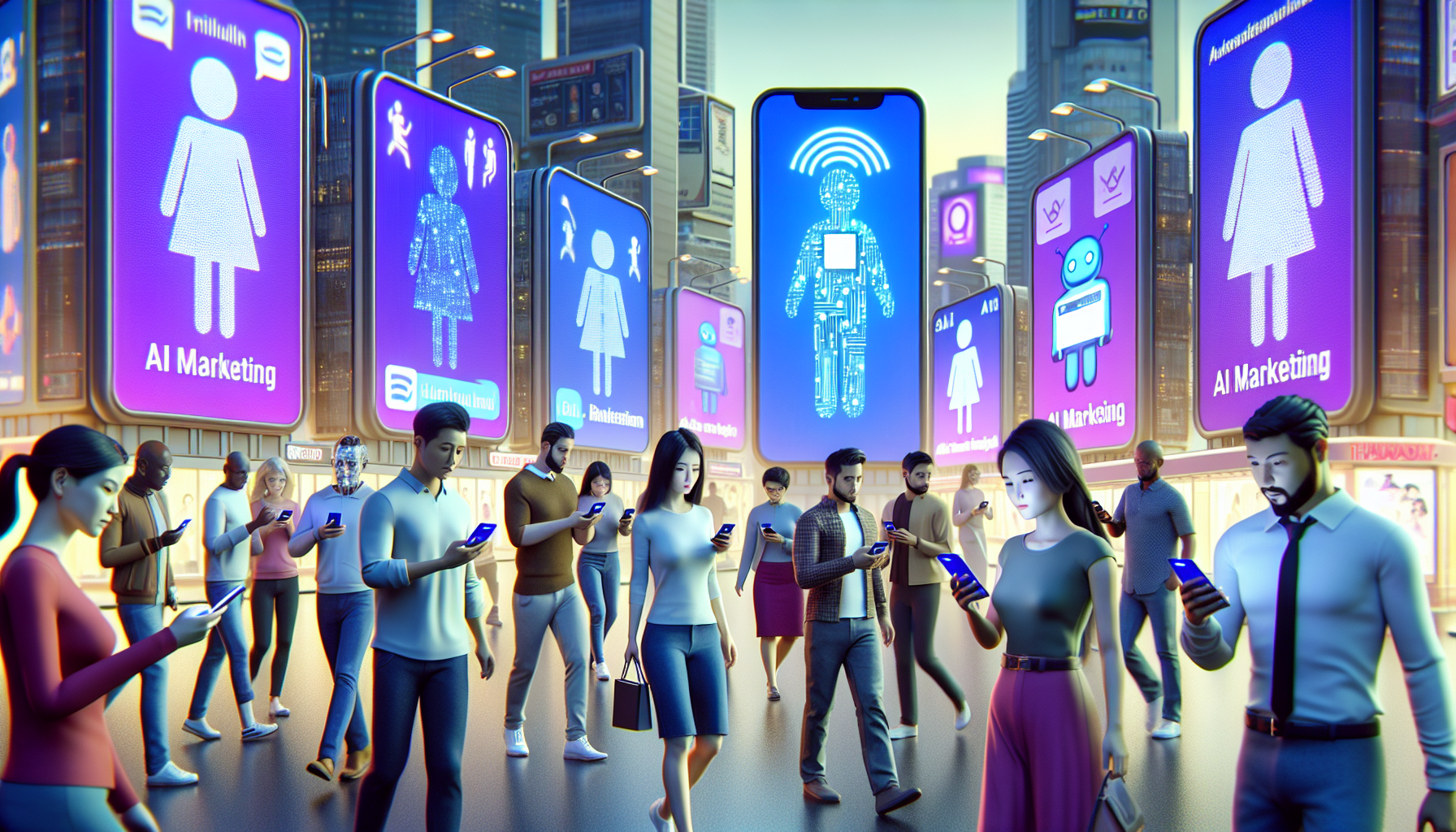AI marketing has revolutionised how businesses approach data analysis, email marketing, customer support, and sentiment analysis. By integrating large language models (LLMs) with AI strategies, companies can leverage predictive analytics for enhanced marketing outcomes, and how to use AI effectively becomes a critical area of expertise[1].[1]
The significance of LLMs in modern marketing cannot be overstated, offering unprecedented capabilities for understanding and engaging customers through advanced data interpretation.
Looking ahead, the challenges of adopting LLMs and AI in marketing outweigh their transformative potential. As businesses become more adept at harnessing these technologies, the future of marketing promises to be more personalised, efficient, and data-driven. This evolution underscores the need for a strategic approach to integrating artificial intelligence within marketing frameworks, ensuring that the impacts of LLMs are optimally utilised for achieving business objectives[1].
Contents
The Evolution of Large Language Models in Marketing
The evolution of Large Language Models (LLMs) in marketing has been a transformative journey deeply rooted in the history of semantics and natural language processing (NLP). This progression can be outlined through critical milestones:
Origins in Semantics and Structuralism
The concept of semantics, pivotal for understanding human and artificial languages, was developed by Michel Bréal in 1883 [1].
Ferdinand de Saussure’s work, Cours de Linguistique Générale, laid the foundation for NLP, influencing the structuralist approach to language in the early 20th century [1].
From Machine Translation to Neural Networks
The Georgetown-IBM experiment 1954 marked the beginning of machine translation, translating 60 Russian sentences into English, setting the stage for future developments in NLP [2].
The use of Hidden Markov Models (HMMs) and n-grams in the 1980s-1990s to predict word sequence probabilities [2].
The introduction of feed-forward neural networks for language modelling by Bengio et al. in 2001 paved the way for deep learning in NLP [2].
Breakthroughs in Model Architecture and Applications
The Transformer architecture, introduced in 2017, revolutionised NLP by enabling parallel processing of sequences, significantly improving model training times [2].
BERT, unveiled by Google researchers in 2018, advanced the use of the Transformer architecture, learning contextual representations of words in a bidirectional manner [2].
GPT-3, introduced in 2020, represented a significant model size and performance leap, boasting 175 billion parameters [2].
The advent of OOpenAI’sChatGPT in 2022 showcased the power of LLMs in generating realistic text, images, and videos, underscoring their utility in research and content creation [1].
The marketing and advertising industry has been at the forefront of adopting AI technologies, with a 37% adoption rate [3]. A 2023 study revealed that 73% of respondents utilised generative AI tools, such as chatbots, indicating a significant integration of LLMs in marketing strategies [3]. This study involved seasoned marketers who evaluated the output of leading LLMs across various marketing use cases, affirming the critical role of LLMs in enhancing marketing outcomes [3].
This evolution highlights how LLMs have become indispensable tools in modern marketing, enabling more sophisticated data analysis, content creation, and customer engagement strategies. Their impact on AI marketing, data analysis, email marketing, customer support, and sentiment analysis has been profound, setting the stage for a future where marketing is more personalised, efficient, and data-driven.
Artificial Intelligence: The Backbone of Modern Marketing
Artificial intelligence (AI) has emerged as a cornerstone in modern marketing, driving innovation and efficiency across various facets. The integration of AI in marketing strategies has been transformative, offering precision in understanding the customer journey and market trends. Here is a detailed look at how AI is reshaping marketing:
AI Technologies in Marketing:
Natural Language Processing (NLP) & Machine Learning (ML): These technologies are pivotal in analysing customer interactions and feedback, enabling sentiment analysis and predictive customer behaviour modelling [5].
AI-driven Smart Automation: Empowers social media managers and customer service teams by enhancing operational efficiency, making it possible to respond swiftly and effectively to customer inquiries or comments [5].
Predictive Analytics: Utilised in various marketing areas such as customer segmentation, lead scoring, and campaign optimisation, predictive analytics offer a data-driven approach to marketing strategies [11].
Impact of AI on Marketing Strategies:
Enhanced Customer Insights: AI and machine learning provide deep insights into customer preferences and behaviour, assisting in strategic marketing decisions [5].
Omnichannel Strategy Optimisation Optimisation through predictive analytics: AI marketing aligns campaigns with market segmentation, targeting customers most likely to engage with the product or offering, thereby driving omnichannel business strategies [5].
Content and Communication: AI-powered platforms aid in developing compelling posts, product descriptions, and successful nurture campaigns by identifying relevant keywords and triggers [5].
Economic Influence and Job TrIt’sHere’sormation:
Global Economy CoIt’sHere’sbution: AI-driven marketing is projected to contribute to 45% of the global economy by 2030, underscoring its significant economic impact [5].
Job Creation: Far from being a job-killer, AI is anticipated to create 2.3 million jobs by 2023, transforming existing roles and opening new avenues for creative and strategic work in marketing [7].
The utilisation of AI in marketing not only streamlines operations and enhances the effectiveness of marketing campaigns but also fosters a more profound connection between predictive analytics; AI enables marketers to craft personalised experiences through predictive analytics, elevating customer satisfaction and loyalty. As AI technologies continue to evolve, their integration into marketing strategies is poised to become even more sophisticated, offering unprecedented opportunities for innovation and growth in the domain of AI marketing [7][8][9].
Integrating LLMs with AI Strategies for Enhanced Marketing Outcomes
Integrating Large Language Models (LLMs) with AI strategies offers a transformative approach to marketing, enhancing content creation, customer engagement, and overall marketing outcomes. Here is a breakdown of the key benefits and applications:
Content Creation and PersonalisatiOpenAI’sIt’salised:
Automated and ScalablOpenAI’sIt’st: LLMs, mainly OpenAI’s GPT-3 and GPT-4, can generate a wide range of content, including blogs, social media posts, and product descriptions, all while maintaining a consistent brand voice across various channels [14]. This automation saves businesses time and resources, allowing for the scaling of content production without compromising quality [14].
Customised PersonalisationCustomised Personalisation is achieved by analysing customer feedback and reviews. Customer Experiences: By analysing customer behaviours, preferences, and interactions, LLMs can create personalised content. This includes product recommendations and emails tailored to each customer, significantly enhancing engagement and fostering loyalty [14].
Customer Service and Engagement:
24/7 Chatbots and Social Media Management: LLMs power chatbots that provide round-the-clock customer support, answer frequently asked questions, and engage with customers on social media. They can also analyse social media trends, schedule posts, and interact with comments and messages, ensuring active and responsive brand pr[14].
Insightful Feedback Analysis By analysing customer feedback and reviews, LLMs extract valuable insights into brand perception by analysing customer feedback and reviews, helping businesses understand and improve their market standing [14].
Strategic Marketing Applications:
Market Research and Data Analysis: LLMs sift through large volumes of data to identify emerging trends, consumer preferences, and patterns. These insights guide strategic marketing decisions, helping brands stay ahead of the curve [14].
Global Content Creation: LLMs create culturally sensitive and relevant content in multiple languages for brands with a worldwide audience, ensuring global resonance and engagement [14].
Creative Campaign Development: Businesses leverage LLMs to brainstorm and generate innovative marketing campaign ideas and slogans, adding a creative edge to their marketingbusiness’s14].
Integrating LLMs into a business’s AI landscape can be achieved with minimal coding, using prompt templates. This integration enhances the efficiency of marketing strategies and complements predictive analytics, improving productivity within a hybrid AI strategy [15]. Moreover, investing in customer relationship management platforms with AI-focused trust layers ensures the responsible use of generative AI, protecting customer privacy while personalising marketing efforts [15]. To maximise the effectiveness of LLMs, businesses should identify which marketing tasks to automate and personalise and consider custom model development or fine-tuning for specific use cases, requiring an in-depth understanding of prompt engineering and training techniques [14][16].
Overcoming the Challenges of LLMs and AI in Marketing
Overcoming the challenges of inteHere’sg Large Language Models (LLMs) and AI in marketing involves effectively addressing computational demands, privacy concerns, and the complexity of developing these technologies. Here’s a structured approach to navigate these hurdles:
Computational Resources and Data Requirements
AI as a Service (AaaS): Utilise AaaS platforms that offer LLMs through APIs, simplifying access to AI capabilities without needing in-house development [17].
Efficient Data Management: LLMs demand extensive, diverse datasets for accurate context comprehension. Businesses should focus on gathering and curating high-quality data to feed into these models [17].
Privacy and Regulatory Compliance
Adhering to GDPR and Other Regulations: Ensure compliance with data protection regulations like GDPR, which set strict rules on data handling and user consent [17].
Private and Hybrid AI Models:
Private Models: Opt for private LLMs trained on datasets provided by the client, offering customisation while maintaining privacy [17].
Hybrid Models: Employ hybrid models that combine public LLM accessibility with private model customisation and privacy, balancing scalability with data protection [17].
Security and Cost Management
Comprehensive AI Security Policies: Develop and enforce AI security policies that describe appropriate model usage. Ensure these policies cover the risks and proper use of LLMs to prevent unauthorised data exposure [19].
Cost-Effective Model Deployment:
Token-Based Pricing: Understand the cost implications, typically calculated per thousandLLMs’ns, and plan budgets accordingly [19].
Automated Observability Tools: Invest in tools that provide complete visibility across all models, LLMs’cing decision-making and ensuring LLMs’ efficient, secure deployment [19].
By adopting a strategic approach that addresses these key challenges, businesses can leverage the full potential of LLMs and AI in marketing, driving innovation and achieving enhanced marketing outcomes while safeguarding data privacy and managing costs effectively.
Looking we’ve: The Future of Marketing with AI and LLMs
Throughout this exploration of the transformative role of Large Language Models (LLMs) and AI intelligence (AI) in marketing, we’ve journeyed from the origins of semantics and structuralism to the cutting-edge applications of AI in modern marketintechnologies’ The intersection of LLMs with AI strategies presents many benefits ranging from content creation, personalisation, customer engagtechnologies’yond, demonstrating these technologies’ profound impact on the marketing landscape. The journey underscores the imperative for businesses to adopt and integrate these innovations, ensuring they remain at the forefront of the digital marketing revolution.
As we look towards the future, integrating AI and LLMs in marketing is about embracing technology and navigating its challenges thoughtfully, ensuring privacy, ethical use, and strategic deployment. The progress in AI marketing promises more personalised, efficient, and data-driven strategies, transforming how businesses connect with their customers. For a deeper dive into the dynamic world of AI marketing and to propel your marketing strategies into the future, consider exploring further resources and insights on this topic. Read more.
PS: I decided to do a test. At the end of some articles, you will find a FAQ to help you answer some questions some of you might be asking.
FAQs
1. How does AI influence marketing strategies?
AI significantly enhances personalisation and customer engagement in marketing. By analysing extensive customer data, AI enables marketers to tailor their strategies to individual behaviours and preferences, leading to more effective and personalised marketing efforts.
2. What exactly are large language models in the context of AI?
Large language models (LLMs) are advanced AI programs capable of understanding and generating text. Trained on vast datasets, they use a type of neural network known as a transformer model to perform various language-related tasks.
3. Can you define AI marketing?
AI marketing involves integrating big data, machine learning, and artificial intelligence to gain a deep understanding of customers individually. Marketers can then deliver hyper-personalised content by merging digital and company channels, aligning with the latest trends focused on catering to customer preferences.
4. What roles do LLMs play in marketing?
Companies in marketing to companies’ strategies through detailed analyses of language patterns and consumer behaviour. These models are adept at creating an audience that precisely meets the target audience’s needs, improving engagement and fostering customer loyalty.









